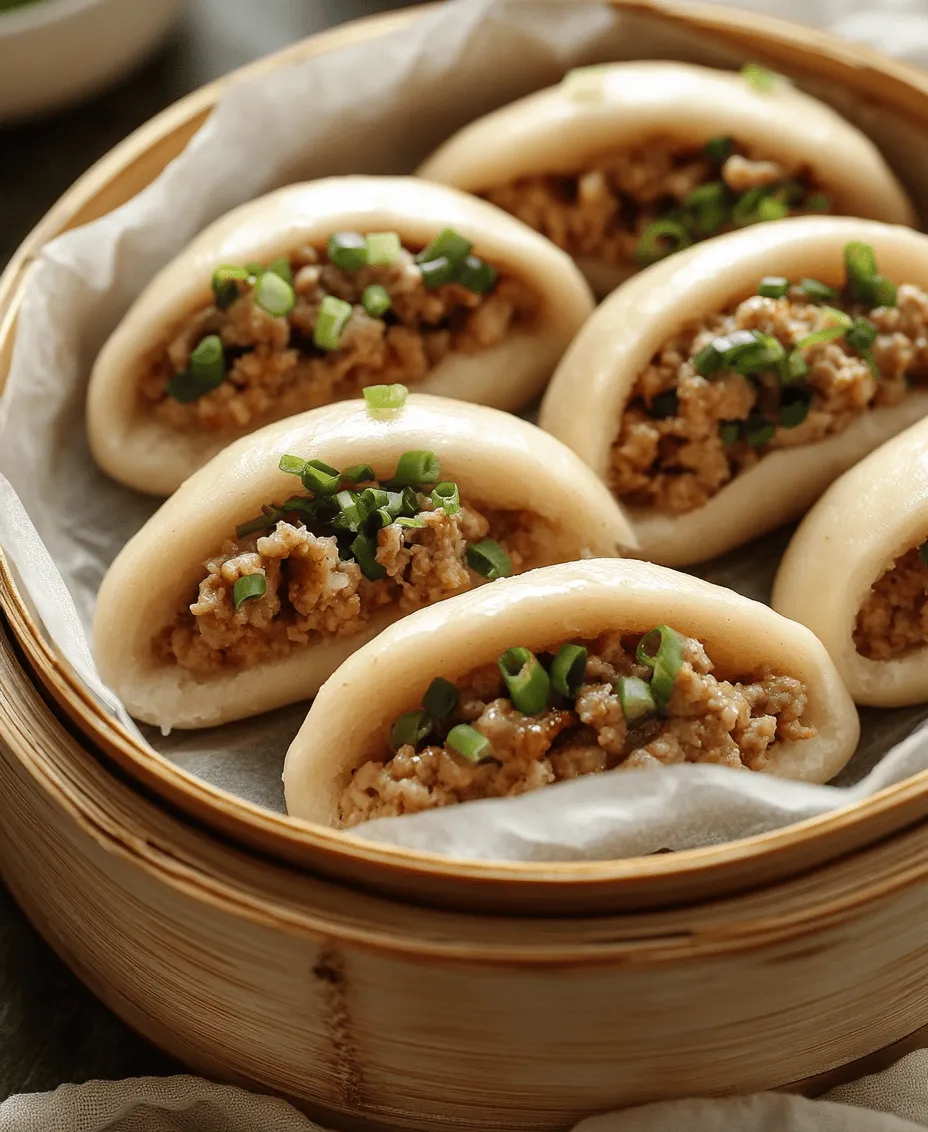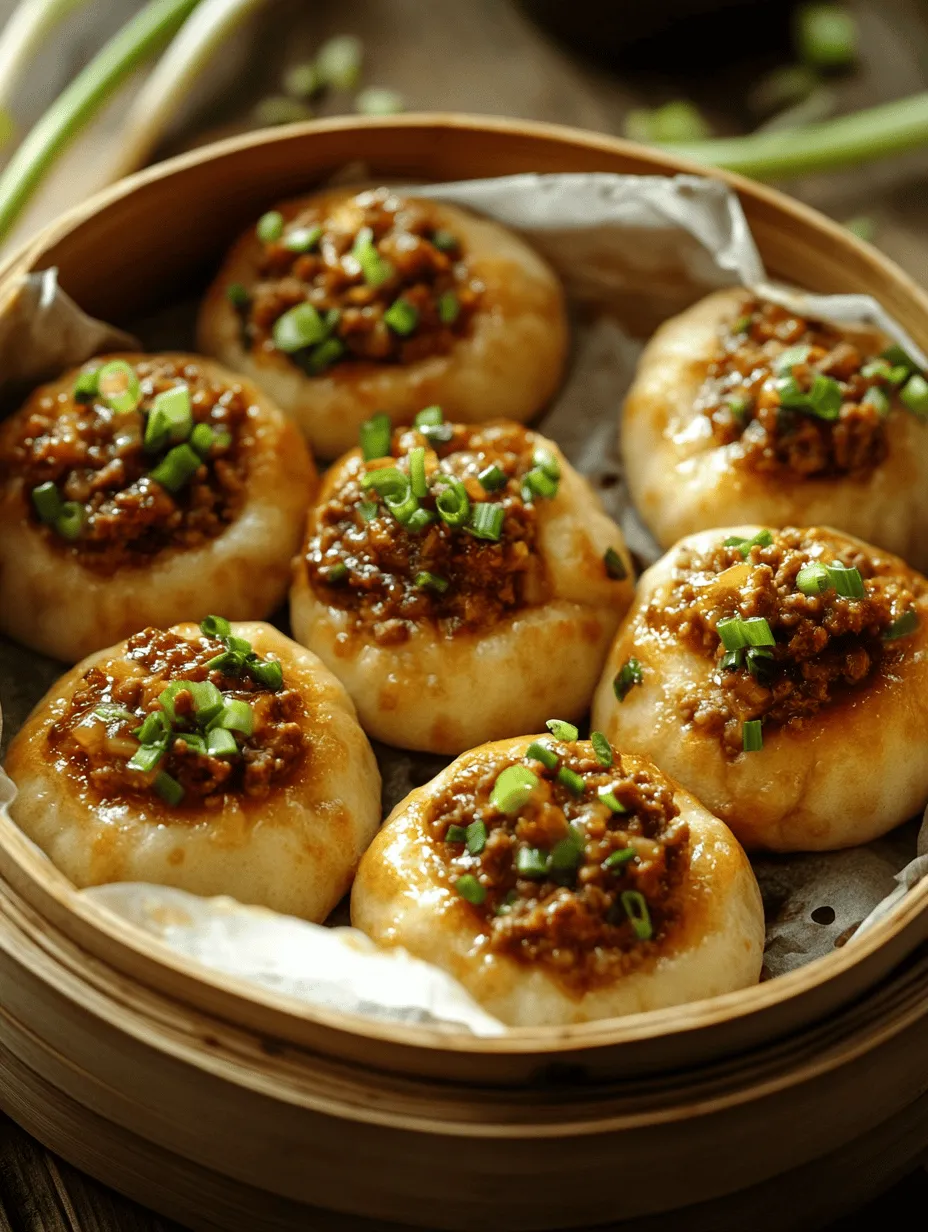Steamed meat buns, also known as baozi or simply bao, are a cherished staple in many Asian cultures. These fluffy, pillowy pockets filled with savory goodness not only warm the heart but also tantalize the taste buds. As comfort foods go, steamed buns hold a special place, making them a popular choice for family meals, festive celebrations, and street food vendors alike. Their versatility allows for a multitude of fillings and flavor combinations, appealing to both traditionalists and culinary adventurers.
The appeal of this soft and savory delicacy lies not just in its delightful taste but also in its simplicity. With the right ingredients and a bit of patience, you can recreate the authentic flavors of steamed meat buns right in your own kitchen. Whether you’re hosting a gathering or simply treating yourself to a comforting meal, this recipe promises to deliver the homemade flavor and satisfaction you crave.
Understanding Steamed Meat Buns
Steamed meat buns are more than just a delicious dish; they are steeped in cultural significance across Asia. Originating in China, these buns have spread throughout the continent, each region adding its unique twist to the basic concept. In China, baozi can be found in various forms, from the thick, fluffy dough of northern styles to the lighter, more delicate versions found in southern regions. The fillings range from traditional pork and cabbage to modern interpretations featuring chicken, beef, or even vegetarian options.
In Japan, a similar concept exists with nikuman, which often features a sweet and savory filling, while in Korea, you might find mandu with a similar steamed approach. Each variant reflects local tastes, culinary traditions, and available ingredients, making steamed meat buns a fascinating study in cultural diversity.
The dough itself is a simple mixture of flour, water, yeast, and sugar, which, when steamed, transforms into a soft, airy bun that perfectly envelops its filling. The steaming process ensures that the buns remain moist and tender, a hallmark of well-made bao. This recipe will guide you through crafting both the dough and a delightful filling, allowing you to experience the joy of making these buns from scratch.
Ingredients Overview
To create the perfect steamed meat buns, you’ll need a few key ingredients, each playing a crucial role in achieving the desired texture and flavor. Below is a comprehensive list of ingredients you will need for both the dough and the filling, along with suggestions for substitutions to accommodate various dietary needs.
For the Dough:
– All-Purpose Flour (4 cups): The foundation of your buns, providing the necessary structure. You can substitute with bread flour for increased chewiness or gluten-free flour for a gluten-free version.
– Warm Water (1 cup): Activates the yeast and hydrates the flour. Ensure the water is not too hot to avoid killing the yeast.
– Yeast (2 teaspoons, active dry): Essential for leavening the dough. You can also use instant yeast without needing to activate it.
– Sugar (2 tablespoons): Adds a slight sweetness to balance the savory filling and helps in yeast activation.
– Salt (1 teaspoon): Enhances flavor and strengthens the dough structure.
– Vegetable Oil (2 tablespoons): Adds moisture and prevents the dough from becoming too sticky.
For the Filling:
– Ground Meat (1 pound, pork or chicken): The star of your filling. Pork offers a rich flavor, while chicken provides a lighter option. You can also use ground turkey or tofu for vegetarian versions.
– Soy Sauce (2 tablespoons): Provides umami flavor and seasoning to the meat.
– Sesame Oil (1 tablespoon): Adds a nutty aroma and depth to the filling.
– Ginger (1 tablespoon, minced): Fresh ginger adds a fragrant spiciness that brightens the overall flavor.
– Garlic (2 cloves, minced): A staple in many savory dishes, garlic contributes a delightful aroma and taste.
– Green Onions (2, chopped): Adds freshness and crunch to the filling.
– Cabbage (1 cup, finely chopped): This is optional but adds texture and moisture to the filling. You can use bok choy or mushrooms as alternatives.
With these ingredients at hand, you’re well on your way to making delicious steamed meat buns. It’s essential to note the importance of each ingredient in enhancing the final product’s flavor and texture.
Preparing the Dough
Step-by-Step Guide to Dough Preparation
Making the dough for your steamed meat buns is a rewarding process that requires a little time and patience. Follow these steps to ensure your dough rises perfectly and results in fluffy buns.
1. Activate the Yeast: Begin by measuring out your warm water (aim for about 110°F or 43°C). Sprinkle the yeast and sugar into the water and let it sit for about 5-10 minutes until it becomes frothy. This indicates that the yeast is active and ready to work its magic.
2. Combine Dry Ingredients: In a large mixing bowl, combine the all-purpose flour and salt. Mix thoroughly to ensure even distribution of the salt, which is crucial for the dough’s flavor and structure.
3. Mix the Dough: Once the yeast mixture is frothy, pour it into the bowl with the flour, along with the vegetable oil. Stir until a shaggy dough begins to form. You can use a wooden spoon or your hands for this step.
4. Knead the Dough: Transfer the dough onto a lightly floured surface. Knead the dough for about 8-10 minutes until it becomes smooth and elastic. This process develops the gluten, giving the buns their characteristic texture. If the dough is too sticky, sprinkle a little more flour as needed, but avoid adding too much, which can lead to dense buns.
5. First Rise: Shape the kneaded dough into a ball and place it in a lightly greased bowl. Cover it with a damp cloth or plastic wrap to prevent it from drying out. Allow the dough to rise in a warm place for about 1-2 hours, or until it has doubled in size. Ideal rising conditions include a warm kitchen or placing the bowl in an oven that has been preheated for a minute and then turned off.
Tips for Ensuring Proper Dough Rise
– Temperature Matters: Yeast thrives in warm environments. If your kitchen is cool, you might consider placing the dough near a warm stove or using an oven with the light on.
– Timing: Be patient! A longer rise may yield better flavor and texture. If you can let it rise longer, even overnight in the refrigerator, the flavor will deepen.
– Dough Poking Test: After the first rise, gently poke the dough with your finger. If the indentation remains, the dough is ready for the next step.
Once your dough has risen beautifully, it’s time to move on to crafting the filling.
Crafting the Filling
Creating a delectable filling is where you can really showcase your culinary creativity. While the dough provides the structure, the filling brings flavor and texture to your steamed buns. Here’s how to prepare a delicious filling:
1. Choose Your Meat: Start with your choice of ground meat. Pork is traditional and offers a rich, savory flavor, while chicken provides a lighter alternative. If you prefer a vegetarian option, consider using finely crumbled tofu or a mix of mushrooms and vegetables.
2. Mix Ingredients: In a large mixing bowl, combine the ground meat with soy sauce, sesame oil, minced ginger, minced garlic, chopped green onions, and chopped cabbage if using. Mix gently but thoroughly to ensure even distribution of flavors. Avoid overmixing, which can make the filling tough.
3. Taste for Seasoning: It’s important to taste your filling before proceeding. Consider frying a small spoonful in a pan to check the flavor. Adjust seasoning as needed, adding more soy sauce for saltiness or more ginger for spice.
4. Chill the Filling: Once your filling is well-mixed and seasoned, cover it and place it in the refrigerator for about 30 minutes. Chilling the filling helps it firm up, making it easier to handle during the assembling stage.
With your dough rising and your filling prepared, you’re well on your way to creating mouthwatering steamed meat buns. The next steps will cover how to shape, fill, and steam your buns to perfection, ensuring each bite is a delightful experience. Stay tuned for more culinary tips and techniques to master this beloved dish!

Assembling the Buns
To create the perfect steamed meat buns, the assembly process is crucial. Begin by preparing your dough and filling, ensuring that both are ready for the next steps.
Shaping and Sealing the Buns
1. Portion the Dough: Once the dough has risen, punch it down gently to release any air bubbles. Divide the dough into equal pieces, typically about 2-3 ounces each, depending on your desired bun size. Roll each piece into a ball and cover them with a damp cloth to prevent drying.
2. Flatten the Dough: Take one ball of dough and place it on a lightly floured surface. Use your palm to flatten it into a disc, about 4-5 inches in diameter. The center should be thicker than the edges to hold the filling better.
3. Add the Filling: Spoon a generous amount of your prepared filling into the center of the dough. Be careful not to overfill; approximately one tablespoon is usually sufficient.
4. Form the Bun: To shape the bun, lift the edges of the disc and fold them toward the center, pinching them together to seal the filling inside. This technique is essential for preventing leakage during steaming. A common method is to create pleats as you work your way around the bun, pinching the dough firmly at each pleat.
5. Final Sealing: Once the bun is fully closed, gently roll it between your palms to smooth out any imperfections. The ideal bun should be round, with no visible seams or openings. This shape not only looks appealing but also ensures even cooking and prevents the filling from escaping.
Steaming Techniques
Now that your buns are assembled, it’s time to steam them to perfection. There are various methods for steaming, each with its own benefits.
Traditional Steamer Setup
– A bamboo steamer is an excellent traditional choice, as it allows steam to circulate evenly around the buns. Line the steamer with parchment paper or cabbage leaves to prevent sticking, making sure to poke holes for steam to escape.
Improvised Methods Using Pots
– If you don’t have a bamboo steamer, you can use a pot with a lid. Place a heatproof plate or a steamer basket inside. Fill the pot with a small amount of water, ensuring that the water does not touch the plate or basket. Bring the water to a boil before placing the buns on the plate.
Spacing for Even Cooking
– Whichever steaming method you choose, ensure there is adequate space between the buns. This allows steam to circulate freely, promoting even cooking. Overcrowding the steamer can lead to unevenly cooked buns, where some may be doughy while others are perfectly steamed.
Steaming Time and Doneness
– Steam the buns for about 15-20 minutes. The exact time may vary depending on the size of the buns and your steaming method. You’ll know the buns are done when they have expanded in size and appear glossy. For a more precise check, insert a toothpick into one of the buns; it should come out clean, indicating that the dough is fully cooked.
Serving Suggestions
Once the buns are steamed and ready, the next step is to serve them. Here are some delightful serving ideas that enhance the experience of enjoying your soft and savory meat buns.
Dipping Sauces and Accompaniments
– A simple soy sauce mixed with a splash of rice vinegar makes for a classic dipping sauce. For those who enjoy a bit of heat, consider adding chili oil or sriracha for an extra kick.
– You could also create a flavorful dipping sauce by combining soy sauce, minced garlic, and chopped scallions, providing a fresh and savory twist.
Complementary Side Dishes
– To create a well-rounded meal, serve the steamed buns alongside some stir-fried vegetables, such as bok choy, broccoli, or a colorful medley of bell peppers.
– A light soup, like miso or a simple vegetable broth, can accompany the buns beautifully, adding warmth and depth to your meal.
Nutritional Information
While steamed meat buns are a delightful treat, it’s important to be mindful of their nutritional content.
General Overview
– Each bun typically contains a good balance of protein from the meat filling, carbohydrates from the dough, and essential nutrients from any added vegetables. However, the nutritional values will vary based on the specific ingredients you choose for your filling.
Portion Sizes and Balanced Meal Considerations
– A standard serving size is about two to three buns, depending on the size and what else is being served. When planning your meal, consider incorporating a variety of food groups to ensure a balanced diet. Pairing the buns with a side of vegetables and a light soup can help achieve this balance, making your meal not only delicious but nutritious as well.
Conclusion
Making homemade soft and savory steamed meat buns is a rewarding culinary experience that offers both joy and satisfaction. The process of preparing the dough, filling, and then assembling and steaming the buns is not just about the end product; it’s about the joy of cooking and sharing food with loved ones.
As you experiment with different fillings and flavors, you’ll discover countless variations that can suit your taste preferences. Don’t hesitate to try new ingredients—vegetables, seafood, or even sweet fillings can transform these buns into unique creations.
Ultimately, sharing these warm, fluffy buns with family and friends embodies the spirit of communal dining and the warmth of homemade cooking. So gather your loved ones, enjoy the fruits of your labor, and relish the delightful experience that is homemade steamed meat buns.



